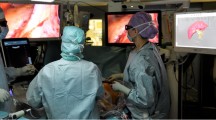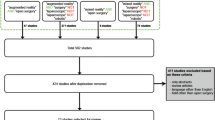Abstract
A liver surgeon's knowledge of anatomy is critical. Due to the patient's small field of vision, patient specific, complex nerve system, and other factors, even a minor loss can result in irreversible damage. Surgeons could benefit from the use of augmented reality (AR) technology, which would bring three-dimensional image data into the operating room. AR visualization can improve surgical procedures, facilitate intraoperative planning, and enhance surgical guidance for the anatomy of interest, all of which contribute to the application's minimal invasiveness. This literature review on image guidance in liver surgery provides the reader with information about AR techniques. To ascertain the current state of Augmented reality technology's application in liver surgery, a PubMed and Embase search were conducted using the following keywords: < (Augmented reality) AND (liver surgery) > and < ‘Augmented reality’ AND ‘liver surgery’ > (publication date from January 1991 until Jun 2022). The query yielded a total of 205 publications—excluded papers in other languages, virtual reality (VR), and reviews leaving 135 studies for review. After removing duplication, the titles and abstracts of those studies were manually reviewed. Finally, 31 pertinent studies were determined to be pertinent to the subject. Generally, augmented reality technology includes preoperative planning and three-dimensional reconstruction, intraoperative three-dimensional navigation, and registration. Visualization may be aided by virtual three-dimensional reconstruction models of the liver from Computed Tomography/Magnetic Resonance Imaging scans. The results demonstrate that by utilizing augmented reality technology, blood vessels and tumor structures in the liver can be visualized during surgery, allowing for precise navigation during complicated surgical procedures. Augmented reality has been demonstrated to be safe and effective in both minimally invasive and invasive liver surgery. With recent advancements and significant effort by liver surgeons, augmented reality technologies have the potential to increase hepatobiliary surgical procedures dramatically. However, further clinical trials will be necessary to evaluate augmented reality as a tool for reducing post-operative morbidity and mortality. The impact of these cutting-edge computerized image guidance techniques on clinically relevant outcome parameters should be assessed in the future.


Similar content being viewed by others
Data availability
Data sharing not applicable to this article as no datasets were generated or analyzed during the current study.
References
Beller S, Hünerbein M, Lange T et al (2007) Image-guided surgery of liver metastases by three-dimensional ultrasound-based optoelectronic navigation. Br J Surg 94:866–875. https://doi.org/10.1002/bjs.5712
Santambrogio R, Vertemati M, Picardi E, Zappa M (2022) Planning the treatment: preoperative 3D reconstruction. Laparoscopic Surgery 6. https://doi.org/10.21037/ls-22-6
Douglas D, Wilke C, Gibson D et al (2017) Virtual reality and augmented reality: Advances in surgery. Biol Eng Med 3:1–8. https://doi.org/10.15761/BEM.1000131
Quero G, Lapergola A, Soler L et al (2019) Virtual and augmented reality in oncologic liver surgery. Surg Oncol Clin N Am 28:31–44. https://doi.org/10.1016/j.soc.2018.08.002
Tinguely P, Fusaglia M, Freedman J et al (2017) Laparoscopic image-based navigation for microwave ablation of liver tumors-A multi-center study. Surg Endosc 31:4315–4324. https://doi.org/10.1007/s00464-017-5458-4
Hashimoto D, Dohi T, Tsuzuki M et al (1991) Development of a computer-aided surgery system: three-dimensional graphic reconstruction for treatment of liver cancer. Surgery 109:589–596. https://doi.org/10.5555/uri:pii:0039606091903894
Yasuda J, Okamoto T, Onda S et al (2018) Novel navigation system by augmented reality technology using a tablet PC for hepatobiliary and pancreatic surgery. Int J Med Robot 14:e1921. https://doi.org/10.1002/rcs.1921
Tang R, Ma L, Xiang C et al (2017) Augmented reality navigation in open surgery for hilar cholangiocarcinoma resection with hemihepatectomy using video-based in situ three-dimensional anatomical modeling: a case report. Medicine 96:e8083. https://doi.org/10.1097/MD.0000000000008083
Hagopian EJ (2020) Liver ultrasound: A key procedure in the surgeon’s toolbox. J Surg Oncol 122:61–69. https://doi.org/10.1002/jso.25908
Shin J, Lee S, Yoon JK et al (2021) LI-RADS major features on MRI for diagnosing hepatocellular carcinoma: a systematic review and meta-analysis. J Magn Reson Imaging 54:518–525. https://doi.org/10.1002/jmri.27570
Willatt J, Ruma JA, Azar SF, Dasika NL, Syed F (2017) Imaging of hepatocellular carcinoma and image guided therapies—how we do it. Cancer Imaging 17:9. https://doi.org/10.1186/s40644-017-0110-z
Aoki T, Mansour DA, Koizumi T et al (2021) Laparoscopic liver surgery guided by virtual real-time CT-guided volume navigation. J Gastrointest Surg 25:1779–1786. https://doi.org/10.1007/s11605-020-04784-3
Mutter D, Soler L, Marescaux J (2010) Recent advances in liver imaging. Expert Rev Gastroenterol Hepatol 4:613–621. https://doi.org/10.1586/egh.10.57
Volonté F, Pugin F, Bucher P, Sugimoto M, Ratib O, Morel P (2011) Augmented reality and image overlay navigation with OsiriX in laparoscopic and robotic surgery: not only a matter of fashion. J Hepatobiliary Pancreat Sci 18:506–509. https://doi.org/10.1007/s00534-011-0385-6
Onda S, Okamoto T, Kanehira M et al (2013) Short rigid scope and stereo-scope designed specifically for open abdominal navigation surgery: clinical application for hepatobiliary and pancreatic surgery. J Hepatobiliary Pancreat Sci 20:448–453. https://doi.org/10.1007/s00534-012-0582-y
Okamoto T, Onda S, Matsumoto M et al (2013) Utility of augmented reality system in hepatobiliary surgery. J Hepatobiliary Pancreat Sci 20:249–253. https://doi.org/10.1007/s00534-012-0504-z
Hallet J, Soler L, Diana M et al (2015) Trans-thoracic minimally invasive liver resection guided by augmented reality. J Am Coll Surg 220:55–60. https://doi.org/10.1016/j.jamcollsurg.2014.12.053
Ntourakis D, Memeo R, Soler L, Marescaux J, Mutter D, Pessaux P (2016) Augmented reality guidance for the resection of missing colorectal liver metastases: an initial experience. World J Surg 40:419–426. https://doi.org/10.1007/s00268-015-3229-8
Banz VM, Müller PC, Tinguely P et al (2016) Intraoperative image-guided navigation system: development and applicability in 65 patients undergoing liver surgery. Langenbecks Arch Surg 401:495–502. https://doi.org/10.1007/s00423-016-1417-0
Luo H, Yin D, Zhang S et al (2019) Augmented reality navigation for liver resection with a stereoscopic laparoscope. Comput Methods Programs Biomed 187:105099. https://doi.org/10.1016/j.cmpb.2019.105099
Schneider C, Thompson S, Totz J et al (2020) Comparison of manual and semi-automatic registration in augmented reality image-guided liver surgery: a clinical feasibility study. Surg Endosc 34:4702–4711. https://doi.org/10.1007/s00464-020-07807-x
Prevost GA, Eigl B, Paolucci I et al (2020) Efficiency, accuracy and clinical applicability of a new image-guided surgery system in 3d laparoscopic liver surgery. J Gastrointest Surg 24:2251–2258. https://doi.org/10.1007/s11605-019-04395-7
Pelanis E, Teatini A, Eigl B et al (2021) Evaluation of a novel navigation platform for laparoscopic liver surgery with organ deformation compensation using injected fiducials. Med Image Anal 69:101946. https://doi.org/10.1016/j.media.2020.101946
Golse N, Petit A, Lewin M et al (2021) Augmented reality during open liver surgery using a markerless non-rigid registration system. J Gastrointest Surg 25:662–671. https://doi.org/10.1007/s11605-020-04519-4
Solbiati M, Ierace T, Muglia R et al (2022) Thermal ablation of liver tumors guided by augmented reality: an initial clinical experience. Cancers 14:1312. https://doi.org/10.3390/cancers14051312
Koo B, Robu MR, Allam M (2022) Global registration in laparoscopic liver surgery. Int J Comput Assist Radiol Surg 17:167–176. https://doi.org/10.1007/s11548-021-02518-7
Adballah M, Espinel Y, Calvet L et al (2022) Augmented reality in laparoscopic liver resection evaluated on an ex-vivo animal model with pseudo-tumours. Surg Endosc 36:833–843. https://doi.org/10.1007/s00464-021-08798-z
Peterhans M, vom Berg A, Dagon B et al (2011) A navigation system for open liver surgery: design, workflow and first clinical applications. Int J Med Robot 7:7–16. https://doi.org/10.1002/rcs.360
Conrad C, Fusaglia M, Peterhans M et al (2016) Augmented reality navigation surgery facilitates laparoscopic rescue of failed portal vein embolization. J Am Coll Surg 223:31–34. https://doi.org/10.1016/j.jamcollsurg.2016.06.392
Koo B, Özgür E, Le Roy B, Buc E, Bartoli A (2017) Deformable registration of a preoperative 3D liver volume to a laparoscopy image using contour and shading cues. International Conference on Medical Image Computing and Computer-Assisted Intervention pp 326–334. https://doi.org/10.1007/978-3-319-66182-7_38
Pfeiffer M, Funke I, Robu MR et al (2019) Generating large labeled data sets for laparoscopic image processing tasks using unpaired image-to-image translation. International Conference on Medical Image Computing and Computer-Assisted Intervention pp 1–8. https://doi.org/10.1007/978-3-030-32254-0_14
Espinel Y, Özgür E, Calvet L et al (2020) Combining visual cues with interactions for 3d–2d registration in liver laparoscopy. Ann Biomed Eng 48:1712–1727. https://doi.org/10.1007/s10439-020-02479-z
López-Mir F, Naranjo V, Fuertes JJ, Alcañiz M, Bueno J, Pareja E (2013) Design and validation of an augmented reality system for laparoscopic surgery in a real environment. Biomed Res Int 2013:758491. https://doi.org/10.1155/2013/758491
Kang X, Azizian M, Wilson E et al (2014) Stereoscopic augmented reality for laparoscopic surgery. Surg Endosc 28:2227–2235. https://doi.org/10.1007/s00464-014-3433-x
Labrunie M, Ribeiro M, Mourthadhoi F et al (2022) Automatic preoperative 3d model registration in laparoscopic liver resection. Int J Comput Assist Radiol Surg 17:1429–1436. https://doi.org/10.1007/s11548-022-02641-z
Pelanis E, Kumar RP, Aghayan DL et al (2020) Use of mixed reality for improved spatial understanding of liver anatomy. Minim Invasive Ther Allied Technol 29:154–160. https://doi.org/10.1080/13645706.2019.1616558
Condino S, Carbone M, Piazza R, Ferrari M, Ferrari V (2020) Perceptual limits of optical see-through visors for augmented reality guidance of manual tasks. IEEE Trans Biomed Eng 67:411–419. https://doi.org/10.1109/TBME.2019.2914517
Nicolau S, Soler L, Mutter D, Marescaux J (2011) Augmented reality in laparoscopic surgical oncology. Surg Oncol 20:189–201. https://doi.org/10.1016/j.suronc.2011.07.002
Vosburgh KG, San José Estépar R (2007) Natural orifice transluminal endoscopic surgery (NOTES): an opportunity for augmented reality guidance. Stud Health Technol Inform 125:485–490
Soler L, Nicolau S, Hostettler A et al (2009) Virtual reality and augmented reality applied to endoscopic and notes procedures. World Congress Med Phys Biomed Eng Munich Germany 25:6. https://doi.org/10.1007/978-3-642-03906-5_101
Funding
The authors have not disclosed any funding.
Author information
Authors and Affiliations
Contributions
All authors contributed to the study conception and design. Material preparation, data collection and analysis were performed by M.A.Bakhshali, F.Gholizadeh and S.R.Mazlooman. The first draft of the manuscript was written by M.Gholizadeh, S.Eslami, A.Modrzejewski, M.Aliakbarian commented on previous versions of the manuscript. All authors read and approved the final manuscript.
Corresponding author
Ethics declarations
Conflict of interests
The authors have no conflicts of interest to declare. All co-authors have seen and agree with the contents of the manuscript and there is no financial interest to report. We certify that the submission is original work and is not under review at any other publication.
Additional information
Publisher's Note
Springer Nature remains neutral with regard to jurisdictional claims in published maps and institutional affiliations.
Rights and permissions
Springer Nature or its licensor (e.g. a society or other partner) holds exclusive rights to this article under a publishing agreement with the author(s) or other rightsholder(s); author self-archiving of the accepted manuscript version of this article is solely governed by the terms of such publishing agreement and applicable law.
About this article
Cite this article
Gholizadeh, M., Bakhshali, M.A., Mazlooman, S.R. et al. Minimally invasive and invasive liver surgery based on augmented reality training: a review of the literature. J Robotic Surg 17, 753–763 (2023). https://doi.org/10.1007/s11701-022-01499-2
Received:
Accepted:
Published:
Issue Date:
DOI: https://doi.org/10.1007/s11701-022-01499-2




